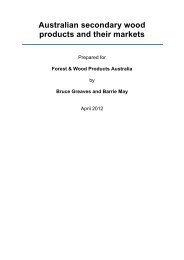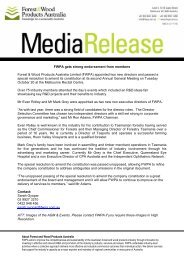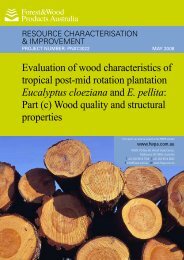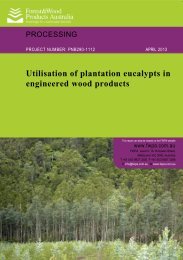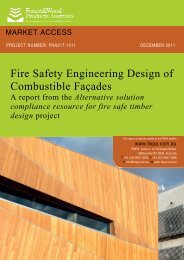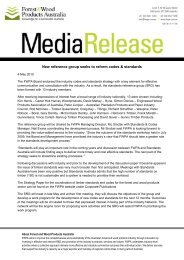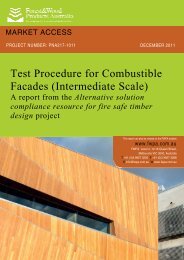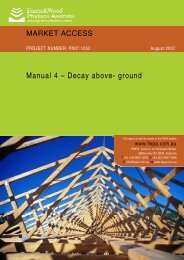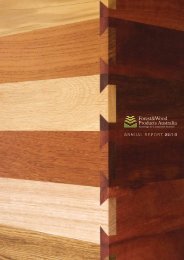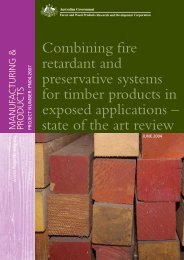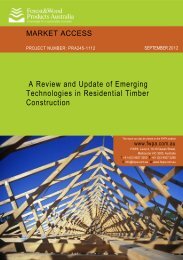guide to the specification, installation and use of preservative treated ...
guide to the specification, installation and use of preservative treated ...
guide to the specification, installation and use of preservative treated ...
Create successful ePaper yourself
Turn your PDF publications into a flip-book with our unique Google optimized e-Paper software.
Special considerations<br />
GUIDE TO THE SPECIFICATION, INSTALLATION<br />
AND USE OF PRESERVATIVE TREATED<br />
ENGINEERED WOOD PRODUCTS<br />
Some complications may arise in relation <strong>to</strong> painting or finishing EWPs. Resin bleed can occasionally<br />
be a problem with s<strong>of</strong>twood components. It occurs naturally in some s<strong>of</strong>twoods <strong>and</strong> appears as a<br />
sticky clear or white exudation from knots or o<strong>the</strong>r imperfections where resin builds up. Where it<br />
occurs, <strong>the</strong> resin should be removed from <strong>the</strong> surface, <strong>the</strong> area allowed <strong>to</strong> wea<strong>the</strong>r or “brea<strong>the</strong>” for at<br />
least a few days, a suitable knot sealant applied, followed by <strong>the</strong> selected surface finish system.<br />
Care is required when painting LOSP (light organic<br />
solvent <strong>preservative</strong>) <strong>treated</strong> EWPs. The presence<br />
<strong>of</strong> solvent <strong>and</strong> water repellent residues may be<br />
detrimental <strong>to</strong> <strong>the</strong> performance <strong>of</strong> some subsequent<br />
surface finishes. Volatile solvents applied during <strong>the</strong><br />
treatment process must be allowed <strong>to</strong> evaporate<br />
(dry) from <strong>the</strong> surface <strong>of</strong> <strong>the</strong> wood prior <strong>to</strong> painting.<br />
It is recommended that LOSP <strong>treated</strong> products are<br />
left for a minimum <strong>of</strong> 7 days after <strong>installation</strong> before<br />
application <strong>of</strong> a suitable surface finish. Finishing<br />
with ei<strong>the</strong>r semi-transparent, penetrating stains or<br />
painting is recommended. A good quality oil-based<br />
primer (acrylic primer recommended for plywood<br />
<strong>and</strong> LVL) is required before <strong>the</strong> application <strong>of</strong> oilbased<br />
or acrylic paint systems.<br />
It is important <strong>to</strong> note AS/NZS1604 specifies that<br />
timber <strong>and</strong> EWPs <strong>treated</strong> <strong>and</strong> marked “H3 A” are<br />
intended <strong>to</strong> be <strong>use</strong>d in predominantly vertical<br />
applications, such as exterior cladding <strong>and</strong> posts,<br />
<strong>and</strong> must have supplementary protection in <strong>the</strong> form<br />
<strong>of</strong> an appropriate, well maintained paint system.<br />
Note that plywood with A or B grade face veneer<br />
quality, which has also been s<strong>and</strong>ed or textured<br />
provides <strong>the</strong> most suitable substrate <strong>to</strong> receive a<br />
high quality surface finish. C or D grade face<br />
veneers contain knots or knot holes <strong>and</strong> o<strong>the</strong>r<br />
imperfections which will not allow high quality<br />
surface finishes.<br />
Durable hardwood Glulam column<br />
finished with semi-transparent exterior<br />
timber stain.<br />
(Courtesy Stephen Bolden)<br />
More detailed guidance on <strong>the</strong> suitability <strong>of</strong> different surface finishes in conjunction with a range <strong>of</strong><br />
treatment types is available from treatment suppliers.<br />
Specific recommendations<br />
The following specific recommendations relate <strong>to</strong> <strong>the</strong> application <strong>of</strong> finishes <strong>to</strong> EWPs:<br />
The Engineered Wood Products Association <strong>of</strong> Australasia (EWPAA) recommends <strong>the</strong> <strong>use</strong> <strong>of</strong> 100<br />
percent acrylic latex paint systems on wea<strong>the</strong>r exposed plywood based on field trial results<br />
(www.paa.asn.au ). A satisfac<strong>to</strong>ry system comprises 1 coat <strong>of</strong> 100 percent acrylic latex stain<br />
blocking primer <strong>and</strong> 2 <strong>to</strong>p coats <strong>of</strong> acrylic latex exterior paint.<br />
Plywood may be supplied with medium density phenolic impregnated paper overlays. Rigid paint<br />
systems including oil-based <strong>and</strong> alkyd enamel paints are suitable for <strong>use</strong> on overlays, but not on<br />
raw plywood surfaces in wea<strong>the</strong>r exposed environments.<br />
Edge sealing <strong>of</strong> panels such as plywood in wea<strong>the</strong>r exposed situations is considered good<br />
practice <strong>and</strong> recommended <strong>to</strong> minimise moisture uptake through exposed wood end grain.<br />
The durability performance <strong>of</strong> LVL cross-arms on power poles has been demonstrated <strong>to</strong><br />
significantly improve by <strong>installation</strong> <strong>of</strong> a quality, light coloured paint finish <strong>to</strong> <strong>the</strong> <strong>to</strong>p horizontal<br />
surface <strong>of</strong> <strong>the</strong> cross-arm.<br />
Page | 31



